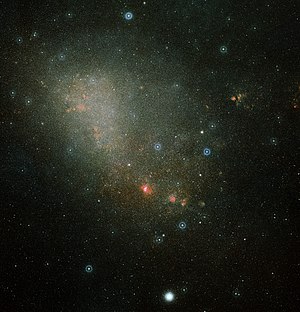Small Magellanic Cloud
| Small Magellanic Cloud | |
|---|---|

Small Magellanic Cloud. Source: Digitized Sky Survey 2
|
|
| Observation data (J2000 epoch) | |
| Constellation | Tucana and Hydrus |
| Right ascension | 00h 52m 44.8s |
| Declination | −72° 49′ 43″ |
| Redshift | 158 ± 4 km/s |
| Distance | 197 ± 9 kly (61 ± 1 kpc) |
| Apparent magnitude (V) | 2.7 |
| Characteristics | |
| Type | SB(s)m pec |
| Size | 7,000 ly (diameter) |
| Apparent size (V) | 5° 20′ × 3° 5′ |
| Notable features | Companion dwarf to the Milky Way |
| Other designations | |
| SMC,NGC 292,PGC 3085, Nubecula Minor | |
The Small Magellanic Cloud (SMC), or Nebucula Minor, is a dwarf galaxy near the Milky Way. It is classified as a dwarf irregular galaxy. It has a diameter of about 7,000 light-years, contains several hundred million stars, and has a total mass of approximately 7 billion times the mass of the Sun. The SMC contains a central bar structure and it is speculated that it was once a barred spiral galaxy that was disrupted by the Milky Way to become somewhat irregular. At a distance of about 200,000 light-years, it is one of the Milky Way's nearest neighbors. It is also one of the most distant objects that can be seen with the naked eye.
With a mean declination of approximately −73 degrees, it can only be viewed from the Southern Hemisphere and the lower latitudes of the Northern Hemisphere. It is located mostly in the constellation of Tucana and also partly in Hydrus and appears as a hazy, light patch in the night sky about 3 degrees across, looking like a detached piece of the Milky Way. Since it has a very low surface brightness, it is best viewed from a dark site away from city lights. It forms a pair with the Large Magellanic Cloud (LMC), which lies a further 20 degrees to the east, and like the LMC is a member of the Local Group.
In the southern hemisphere, the Magellanic clouds have long been included in the lore of native inhabitants, including south sea islanders and indigenous Australians. Persian astronomer Al Sufi labelled the larger of the two clouds as Al Bakr, the White Ox. European sailors may have first noticed the clouds during the Middle Ages when they were used for navigation. Portuguese and Dutch sailors called them the Cape Clouds, a name that was retained for several centuries. During the circumnavigation of the Earth by Ferdinand Magellan in 1519–22, they were described by Antonio Pigafetta as dim clusters of stars. In Johann Bayer's celestial atlas Uranometria, published in 1603, he named the smaller cloud, Nubecula Minor. In Latin, Nubecula means a little cloud.
...
Wikipedia
